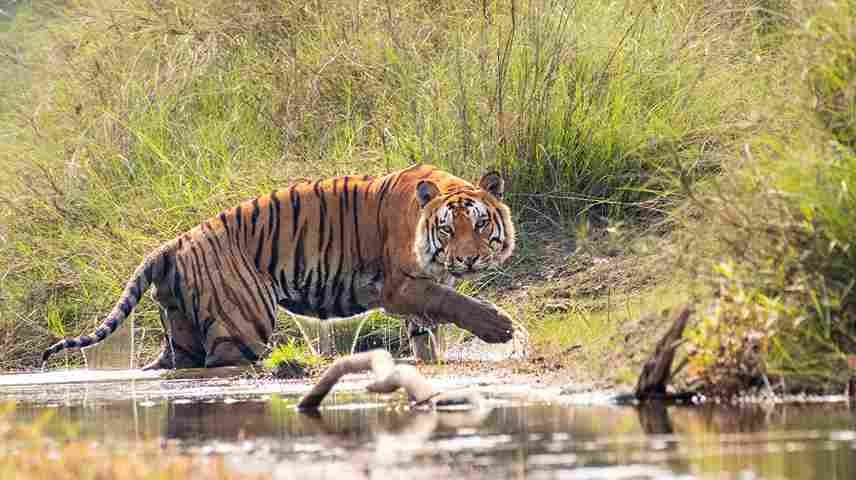Nestled deep in the western Terai region of Nepal, Bardiya National Park is one of the country’s best-kept secrets. Covering an expansive area of 968 square kilometers, this protected area is Nepal’s largest and most undisturbed national park. Unlike its more commercial cousin, Chitwan, Bardiya offers raw, untouched nature, fewer tourists, and greater chances to spot rare wildlife like Royal Bengal tigers, one-horned rhinoceroses, wild elephants, and even freshwater dolphins.
Whether you’re a wildlife enthusiast, eco-traveler, photographer, or someone simply looking for peace and authenticity, Bardiya National Park is the ultimate offbeat destination in Nepal.

bardiya national park
Where is Bardiya National Park Located?
Bardiya National Park is located in Bardiya District, within Sudurpaschim Province of western Nepal. It lies along the eastern banks of the Karnali River, and its boundaries touch the Babai River Valley, Siwalik Hills, and the Churia Range. The area is remote yet accessible by road and air, making it a hidden treasure for true adventurers.
Bardiya National Park is home to more than 53 species of mammals, 407 species of birds, and a wide range of reptiles, amphibians, and insects. The park’s well-protected ecosystem supports thriving populations of some of the most endangered species in South Asia.
Top Animals to See in Bardiya:
Royal Bengal Tiger – Bardiya has one of the highest tiger densities in Nepal
One-Horned Rhinoceros – Translocated from Chitwan to restore the population
Asian Elephant – Often seen near rivers or grasslands
Gangetic Dolphin – Endangered freshwater dolphin seen in the Karnali River
Leopards, Sloth Bears, Gharials, and Marsh Crocodiles also roam freely
For bird lovers, this park is a paradise. Species like Sarus Cranes, Lesser Floricans, Hornbills, and Kingfishers can be spotted throughout the year.
Best Things to Do in Bardiya National Park
Here are some unforgettable activities you can enjoy during your visit:
1. Jeep Safari or Walking Safari
Explore the jungle with trained guides. Walking safaris in Bardiya are famous for close encounters with rhinos and tigers in their natural habitat. Jeep safaris are safer and cover more ground, increasing your chances of sightings.
2. Canoe Ride on the Karnali or Babai River
Enjoy a peaceful canoe ride and spot Gangetic dolphins, gharial crocodiles, and various aquatic birds.
3. Bird Watching
With over 400 species, Bardiya National Park is ideal for both beginners and experienced birdwatchers. Morning and evening hours are best for sightings.
4. Visit the Babai Valley
A less-visited region of the park offering serene landscapes, deep forests, and a real sense of isolation. Perfect for those who want to experience Bardiya without distractions.
5. Tharu Cultural Experience
The indigenous Tharu people have lived in harmony with the forest for centuries. Stay in a Tharu homestay, enjoy their local cuisine, and watch traditional dance performances for a deeper cultural connection.
When to Visit Bardiya National Park
The best time to visit Bardiya National Park is between October and April. During this dry season, the vegetation is thinner, and animals tend to gather near water sources, making wildlife sightings more frequent.
October to February – Cool and comfortable weather, ideal for safaris
March to May – Hotter, but high tiger activity
June to September – Monsoon season, travel is difficult, and park access may be limited
How to Reach Bardiya National Park
By Air:
Fly from Kathmandu to Nepalgunj Airport (~50 mins)
From Nepalgunj, drive 2.5–3 hours to reach the park (Thakurdwara area)
By Bus:
Daily buses run from Kathmandu, Pokhara, or Nepalgunj to Bardiya
It’s a longer journey (12–14 hours), but budget-friendly
By Private Vehicle:
Ideal for road trip enthusiasts or families. Roads are mostly paved and safe.
Where to Stay in Bardiya
Most accommodations are based in or around Thakurdwara, the main gateway to the park. Options range from budget lodges to eco-friendly jungle resorts.
Recommended Stays:
Rhino Lodge Bardiya – Mid-range lodge with safari services
Forest Hideaway Hotel & Cottages – Eco-luxury stay with local architecture
Bardiya Jungle Cottage – Budget-friendly and locally run
Tharu Community Homestays – Experience authentic local life
Bardiya National Park vs. Chitwan National Park
| Feature | Bardiya National Park | Chitwan National Park |
|---|---|---|
| Tourist Crowd | Very low | High |
| Wildlife Sighting | Better tiger visibility | Better rhino sightings |
| Accessibility | Moderate | Very easy from Kathmandu |
| Cultural Authenticity | Deep Tharu cultural experience | More commercialized |
If you’re looking for authentic jungle vibes and rare wildlife encounters, Bardiya National Park is the clear winner.
Responsible Tourism in Bardiya
When visiting Bardiya National Park, it’s crucial to travel responsibly:
Hire certified local guides
Support Tharu homestays and crafts
Follow park rules and animal safety guidelines
Don’t feed or disturb wildlife
Avoid plastic waste and littering
Your actions help preserve this untouched paradise for generations to come.
Bardiya National Park is more than just a national park; it’s Nepal’s last wild frontier, where the sounds of nature replace the noise of cities. With its rare wildlife, rich ecosystems, and authentic culture, Bardiya offers a deep, transformative travel experience unlike anywhere else in the country.
If you’re planning a trip to Nepal and want something beyond the usual trekking routes or city tours, make sure Bardiya National Park is on your list. It’s the place where wild still means wild and where nature whispers its stories to those who listen.
Looking to discover hidden gems like Bardiya National Park? Let ExploreAllAboutNepal guide you to offbeat adventures, cultural insights, and wildlife experiences you’ll never forget.
Visit ExploreAllAboutNepal for more Nepal travel guides, blogs, and insider tips.


